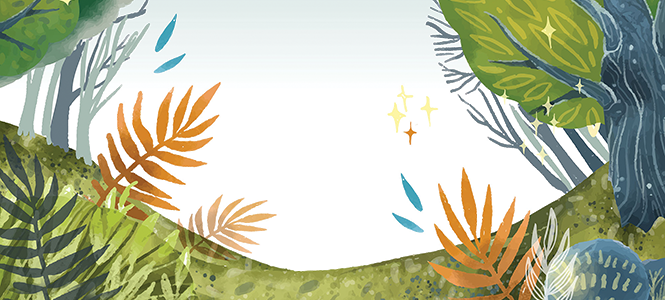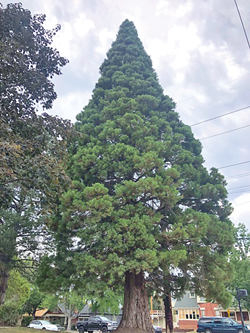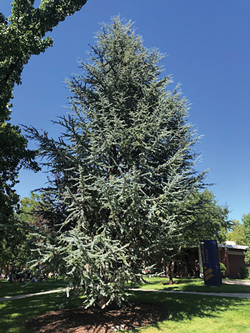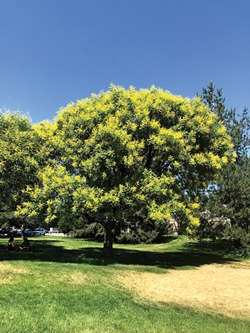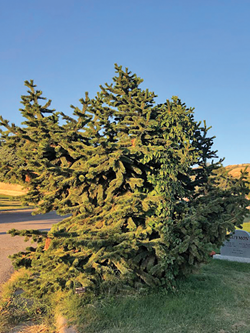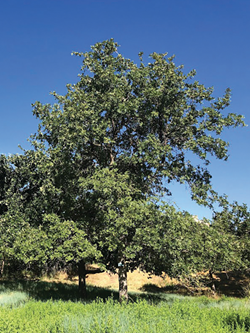When Nalini Nadkarni, forest ecologist and professor emeritus at the University of Utah, moved here from the Pacific Northwest, she imagined Salt Lake City would be a treeless desert. But when she first hiked Ensign Peak and looked out across the cityscape, she was surprised to see what she said was an "ocean of green leaves."
Salt Lake City's tree canopy stems, in large part, from urban forestry, as the arid Salt Lake Valley was once dominated by shrublands and grasses. But strolling through the foothills and ranges, residents can still see many native tree gems, Nadkarni says, including "circles of Gambel oaks along the Shoreline Trail" and "the umbrella-shaped crowns of mountain mahogany."
Inside the city's urban forest, the "ocean of leaves" is composed of a broad, worldly range of individual trees, all worthy of our attention. There are roughly 90,000 trees on public lands in the city and many more on private property, according to Tony Gliot, Salt Lake City's Urban Forestry Division director. "It's the largest urban forest between Denver and Sacramento," Gliot said.
Salt Lake City's unique geography, temperature range and microclimates allow for more tree diversity, depending on irrigation. But it also complicates the arborists' principal aphorism of "right tree, right place," which guides decisions about what types of trees will survive and thrive in a selected place.
The result is a diverse mix of more than 240 distinct species of native and international trees, according to Gliot.
"Diversity really is the building block of a resilient and sustainable ecosystem," says Gliot. Biodiversity benefits ecosystems and urban ecology, but it also invites appreciation of the many different personalities and profiles mixing it up in our urban forest. Each tree provides an opportunity to think about the city, its climate challenges, its communities and its ecologies.
So which trees should Salt Lakers stop to look at?
It's a subjective exercise to make a list of a city's most interesting trees, as every specimen is a potential candidate—a container of stories and traditions, and an arboreal art piece. City Weekly recommends starting with the ones listed below—compiled with the help of local tree experts—and then, maybe, making a list of your own.
"[Trees] please our eyes and enrich our spirits," Nadkarni said.
Giant sequoia (Sequoiadendron giganteum)
Why they're special: This massive redwood species is endemic to isolated groves in the high-altitude slopes of California's Sierra Nevada mountains. There, old-growth sequoias account for the largest single trees by volume.
In Salt Lake City, the giant sequoias are smaller, but make for surprising delights in residents' yards, city cemeteries and arboreta.
"It's awesome that a species that grows on the coastal side of California's mountains also do well in Salt Lake City," says Mike Kuhns, professor emeritus of forestry at Utah State University. "They're so unusual and amazing here."
Sequoias do especially well on small slopes or gulches with good drainage. Look for their trademark conical silhouette and then move in closer to see their soft, shaggy bark that makes for a very huggable texture.
Where to find one: There are many giant sequoias across the city, especially on the University of Utah campus (which doubles as our state arboretum). But a beloved favorite stands sentinel over the corner of the Smith's parking lot on 800 South and 900 East.
Gliot said he passes it often and always thinks, "How is this tree here?" The thick trunk (51 inches in diameter) and dense branching provide an oasis of shade for folks at the wide intersection, and its singular stature can be seen from viewpoints in the Upper Avenues and foothills. Allegedly, there was once a plant nursery at this location, which might account for its unique placement.
Blue Atlas cedar (Cedrus atlantica)
Why they're special: Most of the international trees that succeed in Salt Lake City hail from regions in East Asia. But the blue Atlas—or Atlantic cedar—is native to the Atlas Mountains of North Africa. It sports gorgeous tufts of blue-ish needles similar to Colorado spruces, but in the distinct silhouette and shape of a true cedar like its cousin, the cedar of Lebanon (Cedrus libani).
"Its needles are like stars or fireworks," says Lynsey Nielsen, horticulturist and arborist at Red Butte Garden.
Often, people plant weeping "pendula" cultivars in their yards, which appear like droopy sea-blue sea monsters in the landscape. "It's kind of a freak," says Nielsen of the shape. "But we like weirdos."
Where to find one: There are four "pendula" Atlas cedars planted across an arbor at the entrance to the Children's Garden section of Red Butte Garden. Their branches interlace to form a unique, almost creature-like bridge, which "speaks to the whimsy of our inner-child," says Nielsen.
On Westminster College's campus, two tall, contrasting cultivars stand next to each other like arboreal step-siblings. Dale Bianucci, the college's landscape manager, says the taller one used to perform Christmas tree duties in the student union building before it was planted in the main quad in 1998. It now towers high in cerulean blue color, while its smaller buddy shows off tighter columnar shape and branching. Together, they appear like sculptures in a garden.
Fremont cottonwood (Populus fremontii)
Why they're special: Jeran Farley, Utah's Urban and Community Forestry coordinator, feels that paying attention to trees helps us slow down. And Fremont cottonwoods—with their fast-growing density and deeply furrowed bark—are especially good for that.
Most cottonwood varieties don't live to be particularly large "because they usually grow fast and break apart and die before they really get going," says Farley. More reason to slow down and appreciate the few native giants thriving here across multiple centuries.
Where to find one: Farley and the Utah Community Forest Council (UCFC)—a group of professionals who advocate for education and care of our community forests—have created an online map of heritage trees in Salt Lake County and Utah. A heritage tree, Farley explains, "is a tree that provides historical or unique value to a place."
The arcade of Fremont cottonwoods that line the north entrance to Liberty Park are at least 140 years old—and likely older—based on photographic evidence from 1883. But the most stunning heritage cottonwood is in Fairmont Park, tucked between an artificial stream and the Youth City building.
There, a massive Cottonwood trunk splits into a hydra-like canopy of dense stems. And according to the online Utah Heritage Trees story map, this stand-out cottonwood was planted by Brigham Young in 1863.
Ash trees (Fraxinus americana & Fraxinus pennyslvanica)
Why they're special: The ongoing story of urban ash trees is one of beauty and tragedy. Green and white ashes can be identified by their compound opposite leaf arrangements and distinct light-ash-colored bark, patterned with neatly grooved, criss-crossing furrows. They are tall and majestic in shape, and their gold-yellow foliage glimmers, especially at sunset.
"I dare you to find a better fall color," says Nielsen.
But we're at risk of losing them. Similar to the loss of American elms in the 20th century, many urban forests in the U.S. have experienced a sweeping wreckage of ash trees due to the invasive emerald ash borer (EAB) beetle. In eastern cities, there are few-to-no ashes left.
In Salt Lake City, we're lucky to still have these gorgeous and majestic giants. But they might not be here for long, as EAB has been monitored in Boulder, Colorado. If the beetles cross the Rockies, then Utah's ashes are in trouble, which is why they aren't commonly planted or recommended by most arborists anymore.
In cities where folks planted a majority of ash trees for their beauty, they risk the loss of their urban forest, another reason that biodiversity in urban ecology is important, says Nielsen, who is also a UCFC member. Ashes' future is murky at best—appreciate their beauty now.
Where to find one: There are several streets where ash trees line both sides and create a colorful arbor tunnel in the fall. Some of the best are in Rose Park, where mixes of ashes form towering arcades of majestic bark and compound foliage, especially near the aptly named intersection of Prosperity Avenue and American Beauty Drive.
Also, Gliot says the city is planting a small selection of ashes in the Mark Smith arboretum in the Salt Lake City Cemetery, where they'll be protected and monitored for EAB.
Siberian elm (Ulmus pumila)
Why they're special: Tree people love all trees, right? Right? Few trees breed as much debate as elms.
When Dutch elm disease wiped out the beloved American elm (Ulmus americana) in the mid-20th century, city planners searched for replacements. In Salt Lake City, the disease-resistant Siberian elm, native to Central Asia and Siberia, was already established here and seemed like a good choice.
But the tree has proven to be highly invasive. In The Tree Book, horticulturists Keith Warren and Michael Dirr, who typically praise all trees, write: "This tree deserves to be firewood."
Not everyone agrees. "Every tree has its place," Farley says. Even the Siberian elm.
Ian Peisner, an arborist with TreeUtah—a nonprofit that works with communities to plant and steward trees across the state—says the Siberian elm is an effective shade tree in a city that lacks them and provides nesting space for wildlife.
"People are afraid of what they can't control," he said. "But there are clearly many species using them."
TreeUtah plants disease-resistant, hybrid elms instead of Siberian elms (which plant themselves just fine without any help). But Peisner doesn't like painting all invasive plants with a broad, villainous stroke, especially when it comes to invasive species removal management. "It's not nearly as destructive to the natural ecosystem as Russian olive or tamarisk," Peisner says.
Moreover, the Siberian elm is one of only a few massive shade trees that can tolerate the increasing aridity and rising temperatures of the Salt Lake Valley. "The world is changing, and changing quickly," Peisner said. "It's a frickin' biological miracle it can do what it does here. Why not embrace that?"
Where to find one: If you're looking for stories of ecological resilience, you can find Siberian elms sprouting along fence lines, highways, parking lots and all over. There are some more than century-old specimens lining Stillwell Field in Fort Douglas. And the national champion—or largest known specimen in the country—rests in a private yard in West Valley City, as measured and confirmed by UCFC.
In Jordan Park, there's a provocative mix of American and Siberian elms peacefully coexisting around the pavillion. And surviving American elms—still sprinkled throughout SLC neighborhoods—can be distinguished by their larger leaves and deeper furrows in the bark.
Goldenrain tree (Koelreuteria paniculata)
Why they're special: Like many trees in Salt Lake City's urban forest, the Goldenrain tree isn't native to the area but hails from East Asia. It's a popular choice for street trees since it's shorter than power lines while proving to be tough, pollution-tolerant and heat-resistant, according to Kuhns.
They also rain down long, festive panicles of bright yellow flowers in June after most other trees have cast off their blossoms, making them popular with local pollinators. In late summer and fall, the flowers convert to papery triangular seedpods, inspiring another common name—the Chinese lantern tree.
Where to find one: Sometimes the best example isn't the biggest tree but one that facilitates a hearty social scene. In Sugar House Park, just north of the community garden, two Goldenrain trees form a cool canopy that are dually ebullient with June flowers. Picnickers frequent their shady umbrage, and every Wednesday night in summer, the Salt Lake Scots Pipe Band practices there.
Ian Williams, managing director of the 60-year-old organization, likes the location for the outdoor air, shade and "the sweet smell and beautiful blooms in early summer." It's a wonderful sensory example of culture and nature blending together in the urban forest.
Ginkgo (Ginkgo biloba)
Why they're special: One reason Peisner and Nielsen both love trees is that they offer a very different perspective in timescale than humans. Perhaps no tree does this better than the ginkgo.
In Ginkgo: The Tree that Time Forgot, author Peter Crane writes that ginkgoes—with more than 200 million years of evolutionary history in their order—connect us to "the deep history of our planet." Wild, native populations now exist only in mountain ranges in southern China, but ginkgoes long ago populated most continents, including Western North America 15 million years ago.
Although there's no fossil evidence of them in Utah, their petrified remains can be found at Ginkgo Petrified Forest State Park in Washington, which complicates our view of native ranges when factoring natural history, continental shifts and time. Ginkgoes are the oldest surviving tree species on Earth, and dinosaurs once munched on their fan-shaped leaves. Today, they make wonderful street trees, even in our arid climate, as they've survived millions of years of climate shifts.
Where to find one: In addition to the heritage tree map, UCFC created an online directory of the state's champion trees. According to their records, the state's largest ginkgo resides on a visible corner of the private front yard of a historic building at South Temple and 600 east. There, its lime-green foliage nearly envelopes the adjacent red-brick house's corner turret.
Another stunning example is a stone's-throw from the top of Presidents' Circle on the University of Utah's campus. The tall ginkgo there is female, dropping fruit filled with pungent butyric acid to the regular complaint of some students. This author likes the smell and collateral mess.
Look for younger rows of ginkgoes planted in median strips, along sidewalks and in parking lots throughout the city.
Rocky Mountain bristlecone pine (Pinus aristata)
Why they're special: Its cousin, the Great Basin bristlecone pine (Pinus longaeva), seems to hog all the attention in the family for holding records as the oldest nonclonal trees in the world—the oldest tree of any variety is believed to be a clonal aspen colony in central Utah's Fishlake National Forest—with some great bristlecones living more than 4,000 years in the White Mountains of California. But the Rocky Mountain bristlecone pine is no young slouch.
"It's a cool tree not typically available in nurseries," says Kuhns, which makes it a rare ornamental delight when it pops up on landscapes with its "bottlebrush branching."
While it isn't likely to live thousands of years in an urban setting, these dwarfish pines can live over 2,000 years when the conditions are right. They can be identified by their bottle-brushy pine needles with cute sprinkles of dandruff flakes on them.
Where to see them: One of the spunkier-shaped bristlecone trees squats in the northeast corner of the Salt Lake City Cemetery, which was officially classified as an arboretum in fall of 2021 due to the number of tree species, identification plaques and professional maintenance of trees on the grounds. The cemetery features one of the better collections of conifers in the city and beyond, including an allée of sequoias and this author's favorite Austrian pine in Utah.
Cottam oaks (Quercus spp.)
Why they're special: Utah's native Gambel oaks are resilient, dynamic and often overlooked. They form scrubby thickets in the foothills or taller, mature corridors—with companion Wasatch maples—along creeks and streambanks. They also naturally hybridize with other oak species.
Nielsen says that years ago, Walter Cottam—a renowned Utah ecologist—and a group of his students discovered a grove of natural hybrids of Gambel and turbinella oaks in the Oquirrh Mountains. This inspired Cottam to begin experimenting with different oak combinations in experimental groves, one of which laid the foundation for Red Butte Garden.
Where to find one: According to the online Utah Heritage Trees story map, there is a natural Cottam oak grove inside This Is the Place Heritage Park, where a hybrid acorn launched the half-acre grove about 5,000 years ago. Cottam used pollen from this tree and other sources to create an experimental grove of oak hybrids which remain today behind the horticultural building at Red Butte Garden. There, Nielsen says, 131 oak trees make up 40 different taxa, or species and hybrids. "It's a museum collection just out here."
Nielsen says this grove contains original source material for unique seed varieties that Red Butte sometimes ships to botanic institutions around the world. This space and collection were the foundation and inspiration for Red Butte Garden. "These oaks were the seeds that were planted for a really beautiful botanic garden," says Nielsen.
A note on oaks: Every arborist and professional interviewed for this article advocated for more oak trees in Salt Lake City, especially given the effects of climate change. They all noted that oaks are drought-tolerant boons to ecosystems and provide gorgeous shape and cooling shade if we can patiently let them grow.
"Salt Lake has a small-tree problem," says Nielsen. "The big trees tend to be old ones, but we need to plant many more new ones."
The city has been planting more big-growing trees like oaks on the west side as part of the mayor's 1,000 Trees Initiative, aimed at correcting for historic disparities in tree cover between Salt Lake's neighborhoods, according to Gliot. Decades from now, these oaks might reward us.
Need proof of their beauty sooner? Stroll the England section of the International Peace Gardens and lounge under a pair of massive oaks, including the state champion red oak and its neighboring bur oak, a tough tree with "fuzzy-capped eclectic acorns" that Peisner said he loves to plant.
Sowing Seeds
Salt Lake City is getting hotter and drier, and the acute threat of toxins from the exposed shores of the Great Salt Lake has complicated Utah's environmental trajectory.
A healthy tree provides shade, intercepts particulate matter and supports cooler, cleaner air. To plant and maintain one is to invest in ecosystem health, wildlife shelter and environmental benefits for generations of future Utahns.
Peisner suggests that Salt Lakers get to know the city's trees as neighbors. "You can pay attention to people or to an individual person, and you're going to learn very different things," he said. "Same with trees."
But also, Farley said, "pay attention to where there aren't [trees]. And plant some."
Gliot reiterated that humans and their tree neighbors can thrive around one another. "It is the quintessential example that trees are important enough to people that we take them wherever we go," Gliot said.
Trees and people belong together, especially here and now.
Sam Nelson is a writer, teacher and naturalist. His writing has appeared in The Washington Post, DCist, Two Hawks Quarterly and other outlets. Find him on Instagram @treegazing.
Latest in Cover Story
Readers also liked…
-
Forget the family pedigree—Robert F. Kennedy Jr should not be the next president of the United States
Trojan Horse
- Jun 21, 2023
-
Women decry harassment and toxic culture at St. George auto dealership
Men at Work
- Oct 11, 2023


